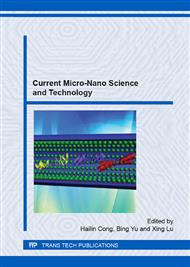[1]
C. M. Soto, and B. R. Ratna, Virus hybrids as nanomaterials for biotechnology. Curr. Opin. Biotechnol. 21 (2010) 426–438.
Google Scholar
[2]
C. X. Yang, A. K. Manocchi, B. Lee, et al., Viral-templated palladium nanocatalysts for Suzuki coupling reaction. J. Mater. Chem. 21 (2011) 187–194.
DOI: 10.1039/c0jm03145c
Google Scholar
[3]
J. Brange, L. Andersen, E. D. Laursen, et al., Toward understanding insulin fibrillation. J. Pharm. Sci. 86 (1997) 517–525.
DOI: 10.1021/js960297s
Google Scholar
[4]
N. Miyaura, T. Yanagi, and A. Suzuki, The palladium-catalyzed cross-coupling reaction of phenylboronic acid with haloarenes in the presence of bases. Synth. Commun. 11 (1981) 513–519.
DOI: 10.1080/00397918108063618
Google Scholar
[5]
J. Ma, Y. G. Ji, H. J. Sun, et al., Synthesis of carbon supported palladium nanoparticles catalyst using a facile homogeneous precipitation-reduction reaction method for formic acid electrooxidation. Appl. Surf. Sci. 257 (2011) 10483–10488.
DOI: 10.1016/j.apsusc.2011.07.007
Google Scholar
[6]
N. B. Milic, and Z. D. Bugarcic, Hydrolysis of the palladium (II) ion in a sodium chloride medium. Transition Met. Chem. 9 (1984) 173–176.
DOI: 10.1007/bf00618610
Google Scholar
[7]
X. F. Zhou, R. Li, B. Dai, et al., The fabrication and electrical characterization of protein fibril -templated one-dimensional palladium nanostructures. Eur. Polym. J. 49 (2013) 1957–(1963).
DOI: 10.1016/j.eurpolymj.2013.04.006
Google Scholar
[8]
F. Leroux, M. Gysemans, S. Bals, et al., Three-Dimensional characterization of helical silver nanochains mediated by protein assemblies. Adv Mater. 22 (2010) 2193–2197.
DOI: 10.1002/adma.200903657
Google Scholar
[9]
J. S. Lim, S. M. Kim, et al., Biotemplated aqueous-phase palladium crystallization in the absence of external reducing agents. Nano Lett. 10 (2010) 3863–3867.
DOI: 10.1021/nl101375f
Google Scholar
[10]
H. Heinz, B. L. Farmer, R. B. Pandey, et al., Nature of molecular interactions of peptides with Gold, Palladium and Pd-Au bimetal surfaces in aqueous solution. J. Am. Chem. Soc. 131 (2009) 9704–9714.
DOI: 10.1021/ja900531f
Google Scholar
[11]
Z. Liu, Z. Y. Du, H. Song, et al., The fabrication of porous N-doped carbon from widely available urea formaldehyde resin for carbon dioxide adsorption. J. Colloid Interface Sci. 416 (2014) 124–132.
DOI: 10.1016/j.jcis.2013.10.061
Google Scholar
[12]
A. F. Lee, J. N. Naughton, Z. Liu, et al., High-pressure XPS of crotyl alcohol selective oxidation over metallic and oxidized Pd(111). ACS. Catal. 2 (2012) 2235−2241.
DOI: 10.1021/cs300450y
Google Scholar
[13]
M. Knez, M. Sumser, A. M. Bittner, et al., Spatially selective nucleation of metal clusters on the Tobacco Mosaic Virus. Adv. Funct. Mater. 14 (2004) 116–124.
DOI: 10.1002/adfm.200304376
Google Scholar
[14]
A. Decottignies, A. Fihri, G. Azemar, et al., Ligandless Suzuki–Miyaura reaction in neat water with or without native β-cyclodextrin as additive. Catal. Commun. 32 (2013) 101–107.
DOI: 10.1016/j.catcom.2012.12.004
Google Scholar
[15]
A. Dewan, U. Bora, and G. Borah, A simple and efficient tetradentate Schiff base derived palladium complex for Suzuki–Miyaura reaction in water. Tetrahedron Lett. 55 (2014) 1689–1692.
DOI: 10.1016/j.tetlet.2014.01.041
Google Scholar
[16]
R. Narayanan, and M. A. El-Sayed, Effect of colloidal catalysis on the nanoparticle size distribution: Dendrimer-Pd vs PVP-Pd nanoparticles catalyzing the Suzuki coupling reaction. J. Phys. Chem. B. 108 (2004) 8572–8580.
DOI: 10.1021/jp037169u
Google Scholar


